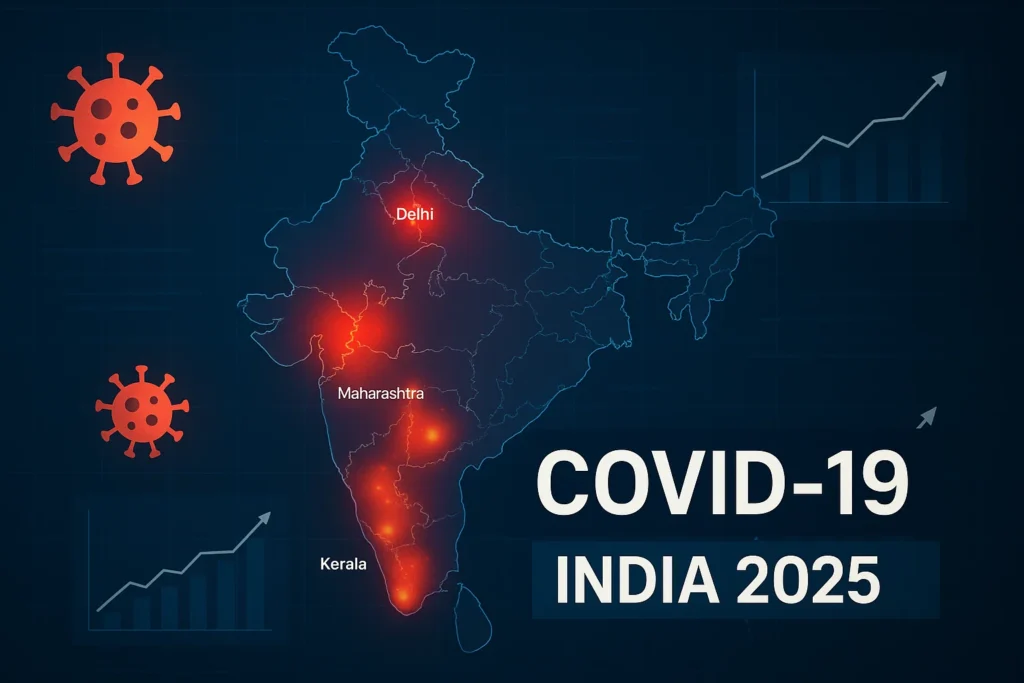
Introduction: COVID-19 Still Isn’t Over in 2025
Just as life in India was regaining normalcy, 2025 has brought a concerning reminder — the COVID-19 virus is still evolving. New subvariants of the Omicron lineage, specifically NB.1.8.1 and LF.7, have emerged in various parts of India, causing a noticeable uptick in infections. While the situation is not as dire as the early pandemic years, the recent spike in cases across major cities and states has reignited discussions on safety, preparedness, and vaccination.
The New Subvariants: NB.1.8.1 and LF.7
According to Times of India, scientists have detected two new Omicron subvariants in India — NB.1.8.1 and LF.7.
Where Were They Found?
NB.1.8.1 has been detected primarily in Maharashtra and Delhi.
LF.7 cases have been reported in Kerala, Karnataka, and Uttar Pradesh.
Symptoms & Differences
These subvariants have shown mild but persistent symptoms, including:
Mild fever
Persistent cough
Fatigue
Body aches
Sore throat
What makes them different from previous variants is their increased transmissibility, but no significant rise in severe illness among vaccinated individuals has been observed so far.
“These variants are not more dangerous but do spread faster,” said a virologist quoted in TOI’s expert opinion section.

COVID-19 Case Surge: Key Indian States
According to the Ministry of Health and Family Welfare COVID Dashboard, the current distribution of rising cases across major Indian states is as follows (as of May 2025):
| State | Active Cases | Daily Increase |
|---|---|---|
| Kerala | 5,400 | +620 |
| Maharashtra | 4,800 | +580 |
| Delhi | 3,950 | +430 |
| Karnataka | 2,300 | +270 |
These numbers, while lower than previous years, have still sparked local-level alerts and hospital readiness reviews.
Localized Surges: Delhi, Noida & Indore
Delhi
Delhi has seen a sharp surge in COVID-19 cases, primarily driven by the NB.1.8.1 subvariant. As per Economic Times, daily cases have more than doubled in a week. Some private hospitals have reactivated COVID wards as a precaution.
Noida
In neighboring Noida, schools have reported minor outbreaks. Health authorities are urging parents to keep children with symptoms at home. Rapid antigen testing booths have been reintroduced in high-traffic areas.
Indore
The city of Indore has also reported a noticeable spike, especially among senior citizens and healthcare workers. Nava Bharat Times highlights that local clinics are advising precautionary measures for those with co-morbidities.

Hospital Preparedness: A Look at Prayagraj
In Prayagraj, SRN Hospital has already prepped over 150 isolation beds and 10 ICU units in anticipation of a localized spike. The hospital administration noted that oxygen supplies, ventilators, and PPE kits are in place, though no major surge has hit the city yet.
What Do Health Experts Say?
Most experts agree that the situation doesn’t call for panic, but it does demand vigilance.
Dr. Neeraj Gupta, a pulmonologist from Delhi, shared with Times of India that “existing vaccines are still effective in preventing severe illness, but boosters are strongly recommended, especially for vulnerable groups.”
The Indian Council of Medical Research (ICMR) has emphasized masking in public spaces and avoiding mass gatherings in high-transmission zones.
Vaccination & WHO Guidance
The World Health Organization (WHO) recently reiterated the importance of vaccinating elderly populations, individuals with underlying conditions, and frontline workers.
Booster doses are available at most government health centers across India.
A bivalent booster targeting Omicron subvariants is under final testing and may be released by mid-2025.

Practical Safety Tips for Everyone
Even though the variants are milder, prevention remains the best approach:
✅ Must-Do Safety Measures
Wear a mask in crowded or enclosed areas
Sanitize hands frequently
Maintain physical distance in public places
Avoid close contact if you’re feeling sick
Stay updated with your booster shots
Use air purifiers or ventilate rooms regularly
💡 For Schools and Workplaces
Ensure sick leaves for symptomatic individuals
Increase remote work flexibility in high-case areas
Promote hybrid or staggered schedules if needed
Past vs Present: How 2025 Compares
While the early years (2020–2022) saw massive disruptions, India’s health system in 2025 is more prepared. We now have:
Widespread vaccine coverage
Experienced medical staff
Informed citizens
Proactive policy responses
But with the virus still evolving, complacency is not an option.
Conclusion: Stay Cautious, Not Fearful
India’s COVID-19 landscape in 2025 is marked by caution, not crisis. With the emergence of NB.1.8.1 and LF.7, it’s essential to stay alert, get vaccinated, and follow simple safety measures. The government, hospitals, and health bodies are ready — now it’s our turn to do our part.
As always, trust verified sources, stay informed, and keep yourself and your loved ones safe.
Stay Informed Resources:
FAQ ( Frequently Asked Question )
These are newly identified Omicron subvariants spreading in India in 2025. They were first reported in states like Kerala and Maharashtra, with symptoms including high fever, fatigue, and sore throat—similar to earlier strains but slightly more contagious.
According to experts cited in Times of India, these subvariants are not causing more severe illness but are spreading rapidly. Most cases are mild, especially among vaccinated individuals.
States like Kerala, Maharashtra, Delhi, and Karnataka are seeing significant surges. Cities like Noida, Indore, and Prayagraj are also experiencing spikes in cases and hospital admissions.
Yes, the WHO and MoHFW recommend booster doses, especially for the elderly, immunocompromised individuals, and frontline workers. Stay updated on local government announcements for booster availability.
Wear a mask in crowded or indoor public places, maintain social distancing, sanitize hands frequently, avoid unnecessary travel, and get vaccinated or boosted as per guidelines.
Related Keywords
COVID-19 India 2025
NB.1.8.1 variant symptoms
LF.7 COVID variant India
New COVID variants in India
Rising COVID cases in Kerala
Maharashtra COVID-19 update
Delhi COVID-19 surge 2025
COVID-19 hospital preparedness Prayagraj
SRN Hospital COVID readiness
WHO COVID-19 vaccine guidance 2025
COVID-19 safety measures 2025
COVID-19 booster dose India 2025

One Comment
[…] The COVID-19 pandemic didn’t just challenge our physical health; it profoundly affected our mental well-being. Lockdowns, social isolation, and economic uncertainties led to a surge in anxiety, depression, and other mental health issues worldwide. The strain on mental healthcare systems became evident, highlighting the urgent need for integrating mental health into primary healthcare and expanding digital mental health services. […]